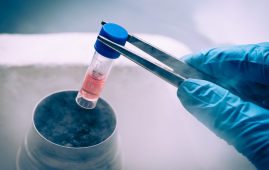

Researchers from the University of Birmingham’s Institute of Cardiovascular Sciences, led by Professor Steve Watson and Dr Eleyna Martin, have produced the first binding molecules (ligands) of defined composition to make platelets clump together in a predictable way through ‘nanobody’ technology.
The researchers created nanobodies from antibody fragments and crosslinked them to create ligands for four platelet receptors (GPVI, CLEC-2, FcRIIA, and PEAR1).
“We are entering an exciting period in thrombosis research. Reagents based on nanobodies will increase our understanding of platelet activation in the laboratory. Although nanobodies have a short half-life in vivo, this could be counteracted by linkage to larger inert molecules and yield novel therapeutics for blood and thrombotic disorders.”- Professor Steve Watson, Institute of Cardiovascular Sciences and Head of the Birmingham Platelet Group
The nanobodies can be utilized to provide validated clinical diagnostics for patients with platelet abnormalities including bleeding or thrombosis, as well as research tools for studying platelet activation.
“Nanobodies have the same properties as antibodies but have several inherent advantages for platelet researchers,” said Professor Watson. They are smaller, making them better for cross-linking, and their small size, combined with their stability and strong affinity for platelet receptors, makes them ideal reagents for receptor imaging.”
Scientists already know that when these four receptors cluster on the platelet surface, signaling chemicals are released, causing platelets to activate and clot.
They do, however, have a limited grasp of the link between cluster size, signal production, and platelet activation.
Due to the limits of the currently employed ligands, further study in this field is limited. Some have unknown valency (binding power), while others, such as the snake venom toxin rhodocytin, exhibit high batch variation or uncertain receptor specificity.
The researchers from Birmingham created nanobodies with one, two, three, and four binding sites and assessed their ability to generate signaling molecules and promote platelet activity. Their findings were published in the Journal of Thrombosis and Haemostasis this week.
The Birmingham Platelet Group has previously demonstrated the applicability of nanobodies in biological research in two papers1,2.
Professor Steve Watson and Dr Natalie Poulter used new nanobodies generated by the team to bind to the GPVI receptor in these tests. This receptor, which is found on platelet membranes, is an appealing target for pharmacological therapy since it is important in thrombosis (clot formation) but only plays a modest role in haemostasis (the stopping of bleeding from a blood artery).
In the first study, the researchers utilized a nanobody called Nb28 that they labeled with a fluorescent dye, allowing them to see GPVI receptors clustering on platelets in flowing blood for the first time. In the same study, they discovered that a nanobody dubbed Nb2, which has a high binding affinity for GPVI, may potently suppress platelet activation and stop thrombus formation, potentially making it appropriate for development into an anti-thrombotic drug.
The same researchers demonstrated in the second study that there is a relationship between cluster formation and thrombus size, and that cluster size is related to thrombus formation, with the formation of GPVI’macroclusters’ supporting the formation of significantly larger platelet aggregates.
“We are entering an exciting period in thrombosis research,” Professor Watson stated. In the laboratory, nanobodies-based reagents will improve our understanding of platelet activation. Although nanobodies have a short in vivo half-life, this could be mitigated by linking to bigger inert molecules, yielding potential therapies for blood and thrombotic disorders.”
more recommended stories
 Circadian Control of Neutrophils in Myocardial Infarction
Circadian Control of Neutrophils in Myocardial InfarctionKey Takeaways for HCPs Neutrophil activity.
 E-Cigarette Use and Heart Attack Risk in Former Smokers
E-Cigarette Use and Heart Attack Risk in Former SmokersKey Takeaways for Clinicians and Nurses.
 36-Week Pre-eclampsia Screening May Reduce Term Risk
36-Week Pre-eclampsia Screening May Reduce Term RiskA New Preventive Strategy for Term.
 Cardiovascular Risk and Sudden Cardiac Death in Diabetes
Cardiovascular Risk and Sudden Cardiac Death in DiabetesRising Sudden Cardiac Death (SCD) Risk.
 Poor Kidney Function and Alzheimer’s Biomarkers Explained
Poor Kidney Function and Alzheimer’s Biomarkers ExplainedPoor kidney function may influence levels.
 Walking Speed Before Hip Replacement Predicts Recovery
Walking Speed Before Hip Replacement Predicts RecoveryNew Evidence Points to a Simple,.
 Neuroblastoma Drug Combo Extends Survival in Models
Neuroblastoma Drug Combo Extends Survival in ModelsA Promising Shift in High-Risk Neuroblastoma.
 Safer Allogeneic Stem Cell Transplants with Treg Therapy
Safer Allogeneic Stem Cell Transplants with Treg TherapyA new preclinical study from the.
 How Soybean Oil Impacts Weight Gain and Metabolism
How Soybean Oil Impacts Weight Gain and MetabolismWhy Soybean Oil May Affect Metabolism.
 Coffee and Cognitive Function: Evidence Review
Coffee and Cognitive Function: Evidence ReviewA new narrative review in Cureus.

Leave a Comment